Service Navigation
Search
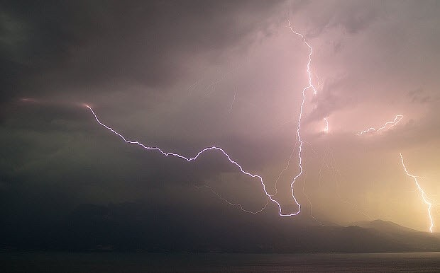
Even in a small country like Switzerland, there are large variations in thunderstorm frequency, depending on the region. The lightning density in southern Ticino is among the highest in Europe, and can be as much as four lightning strikes per year per square kilometre. However, some regions of the world have a much higher lightning density.
Unlike ground-based lightning detection systems, which capture nearby strikes and integrate them into a regional to continental mosaic, satellite-based systems enable global lightning detection and processing. The measurement systems are fundamentally different: ground-based systems measure the electromagnetic signals emitted by lightning, while sensors on satellites observe the glow caused by lightning. Satellite sensors are more sensitive and, therefore, from space it is possible to detect about two to three times more lightning strikes than with conventional ground-based systems.
An early device, the Optical Transient Detector (ODT), was in use from 1995 to 2000. It was located on board an Earth-orbiting satellite at an altitude of 740 km. An optical sensor enabled lightning to be recorded anywhere on Earth, except in the polar regions. This device, developed by NASA from the 1980s, was the predecessor of the LIS (Lightning Imaging Sensor), which was in operation for longer.
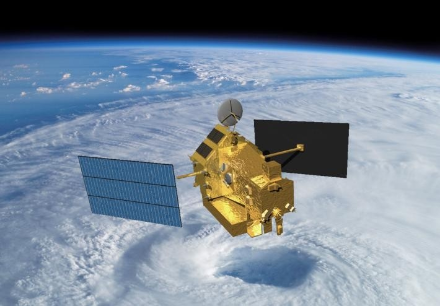
The LIS lightning sensor in the TRMM (Tropical Rainfall Measuring Mission) Earth observation satellite of NASA and the Japanese space agency JAXA was in operation between 1997 and 2015. This optical instrument was able to record lightning between the equator and the 38th northern and southern parallels. The mission, originally planned to last three years, finally ended after 17 years. In addition to the optical lightning sensor, there was also equipment on board the Earth-orbiting satellite to study precipitation patterns in the tropical and subtropical regions.
The third generation of the EUMETSAT satellites (commissioned in 2021) is also fitted with a lightning recorder called the Lightning Imager. EUMETSAT is the European Organisation for the Exploitation of Meteorological Satellites. It operates weather satellites and makes the observation data available to its member states.
Annual cycle of global lightning climatology
Lightning occurs most frequently at the tropical and subtropical latitudes, as demonstrated by the plot chart of the average number of lightning strikes per km2 per year from 1995 to 2010. It also shows that lightning occurs more frequently over land than over sea. The reason for this is that different radiation conditions prevail over continents than over the oceans. During the warm season, land masses heat up more than the oceans. This means that the convective processes (condensation of water vapour and cloud formation as a result of rising air) that can develop into thunderstorms are much more pronounced in those regions.
This effect also explains why lightning strikes are far more frequent in the northern hemisphere: The surface area of the continents in the northern hemisphere is larger than that in the southern hemisphere. Globally speaking, the most lightning strikes occur on average in the afternoon between 12 noon and 6 p.m. In the northern hemisphere, the highest number of lightning strikes is recorded between June and August, and in the southern hemisphere between December and February.
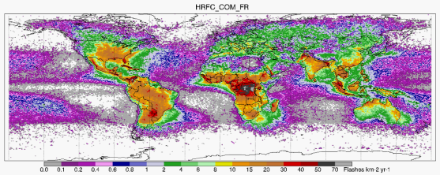
Thunderstorms are much less frequent in Europe than in subtropical regions. However, this does not mean they are any less heavy. At temperate latitudes, severe thunderstorms with gusting wind, hail and floods are often seen in summer. The region in Europe with the most lightning strikes is near the Swiss border, on Lake Como in northern Italy.
Thunderstorm and lightning frequency in Switzerland
The regions with the most lightning
The regions with the most lightning are located between the equator and the northern and southern 38th parallels. The lightning frequency in these regions was recorded over a period of 17 years during the Tropical Rainfall Measuring Mission (TRMM). These data have been used to create complete lightning climatologies as part of various scientific studies.

According to a study by Rachel et al. (2016) based on high-resolution data, Africa is the continent with the highest frequency of lightning strikes. The analysis showed that the region with the most lightning strikes was not the eastern Congo basin in Africa, as previously assumed, but Lake Maracaibo in Venezuela. As part of this study, a list was also compiled of the
500 locations most affected by lightning in the regions overflown by the TRMM satellite (0–38° N/S). The number of lightning strikes per square kilometre within one year (Flash Rate Density, FRD) was calculated for each year. None of these locations are in Europe.
Even though the most recent data used in this study are from 2013, the results are still valid today. Despite global warming, the distribution of Earth’s most lightning-dense zones has not changed significantly.
The five regions with the most lightning on each continent plus other special regions
- South America
- Africa
- North America
- Asia
- Oceania
South America
In South America, there are five hotspots with a higher lightning rate. These are distributed over Colombia and Venezuela. Lake Maracaibo is the region with the most lightning in the world, with 233 lightning strikes per km2 per year.
Over Lake Maracaibo in Venezuela, the largest inland waterbody in South America, a unique natural spectacle can be seen at night: Lightning illuminates the tropical darkness on up to 260 nights a year, especially at the spot where the Río Catatumbo flows into the lake. With up to 60 flashes per minute, or almost 1,176,000 flashes a year, this phenomenon is even in the Guinness Book of Records.
The lightning occurs so frequently at night that this region once served as a lighthouse for Caribbean sailors in colonial times. This phenomenon (known in Spanish as Relámpago del Catatumbo) remains full of mystery to this day, and there are numerous theories surrounding the unusual electrical activity.
However, the reason for it is relatively simple: Lake Maracaibo lies between two mountain ranges of the Andes massif. During the day, large amounts of water evaporate from the lake due to the high surface temperature, which averages 30 degrees. In addition, the Caribbean Sea in the north adds to the moisture. During the night, the air cools rapidly over the nearby Andean peaks, and winds form over the two mountain ranges to the west and south, converging over the warm lake. The pronounced wind convergence combined with moist, unstable air stratification provides an additional trigger for the uplift process required for thunderstorms. As a result, large, vertical thunderstorm cells regularly form over the lake and its surroundings during the evening and at night.
All the other hotspots in South America are in Colombia. The frequency of lightning strikes is also very high in that region compared to other parts of the world, especially in the foothills of the northern Andes massif. This level is only surpassed by some regions in Pakistan and India. In many of the Colombian thunderstorm regions, the greatest amount of electrical activity is recorded at night. This is probably also due to stationary convergence (reverse thermals), given the topography.

Africa
Eight of the ten regions with the most lightning strikes in Africa are in the Democratic Republic of Congo. With an annual frequency of 205 lightning strikes per km2, the Kabare district has a similar intensity to that of Lake Maracaibo in Venezuela, putting it in second place globally. In terms of its annual average and taking the entire region into consideration, the Democratic Republic of Congo is the most thunderstorm-prone country on earth. Nguti in Cameroon is the fourth most thunderstorm-prone region in Africa, and eighth in the world. Thunderstorms occur throughout the year in West and Central Africa, although they are most active between September and May.
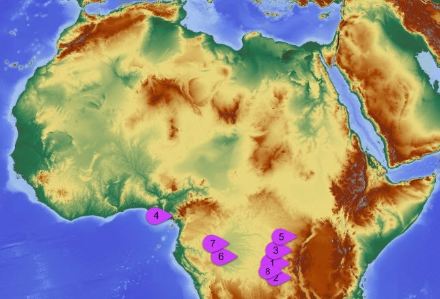
Central and North America
The regions with the most thunderstorms on the North American continent are in Central America. The two places that top the list, with an FRD of 117 and 103 per km2 per year respectively, are both in Guatemala. These two regions where the most lightning strikes occur are likewise located at the foot of a mountain range, the Sierra Madre. Thunderstorms are frequent during the summer months, especially in Patulul, not far from Lago de Atitlán, which is a popular tourist destination. In these areas, the peak of electrical activity is reached during the afternoon. The region in the USA with the most thunderstorms is Orangetree in Florida. Activity there peaks in July.
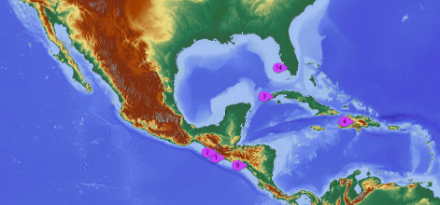
Asia
The three regions in Asia with the most thunderstorms are all in Pakistan. Violent thunderstorms with intense electrical activity develop there in July and August, especially in Daggar in the Hindu Kush foothills. The highest monthly lightning frequency in the world has been observed here in August, exceeding even that of the most thunderstorm-prone months in the Congo. In Rajouri, in the far west of the state of Jammu and Kashmir, violent thunderstorms with tornadoes, heavy hailstorms and flooding are also observed during the monsoon. These regions are located at the foot of the Himalayas and have the greatest amount of electrical activity during the monsoon months between May and October, and especially in August and September. Again, the most violent thunderstorms occur at the foothills. In these regions, the warm, moist air of the southwestern monsoon from the Arabian Sea meets the cold, dry air descending from the Tibetan Plateau.
The lightning climatology of Kuala Lumpur, the capital of Malaysia, is also interesting. With an FRD of 93 lightning strikes per km2 per year, it ranks only tenth in Asia, but it is the world’s most lightning-prone capital city. Overall, Kuala Lumpur ranks number 52 in the 500 most lightning-prone regions of the world.
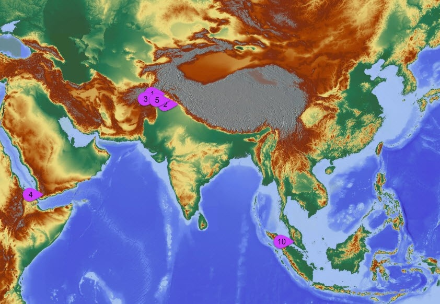
Oceania
In Oceania, four of the regions with the most intense electrical activity are in the same area, namely on the northern Australian coast. However, Australia’s region with the most lightning is only ranked number 61 in the world. The fifth most lightning-prone region is in Papua New Guinea. The high frequency of lightning in the two countries comes from the afternoon convergence of wind from ocean and land, and occurs particularly during the summer monsoon.
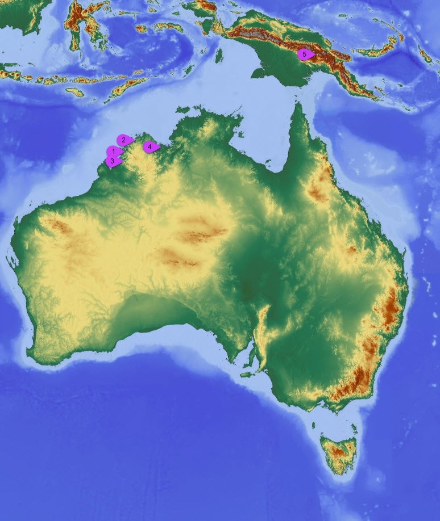
Time lapse of lightning frequency at the ten hotspots across all continents
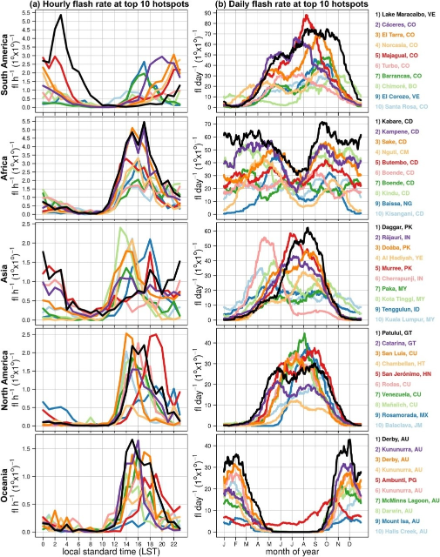
With the help of climatological analyses of lightning strikes on Earth by satellites, earlier observations have now been confirmed: Greater amounts of electrical activity are recorded over land than over sea, especially in the mountainous regions of the Himalayas, the Andes, the Sierra Madre and the Mitumba Mountains in Africa. The highest density of lightning strikes has been recorded in the summer months and during the monsoon season in many regions. Overall, Lake Maracaibo was identified as the region with the most lightning in the world.